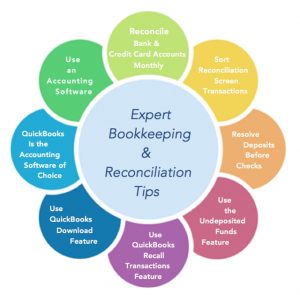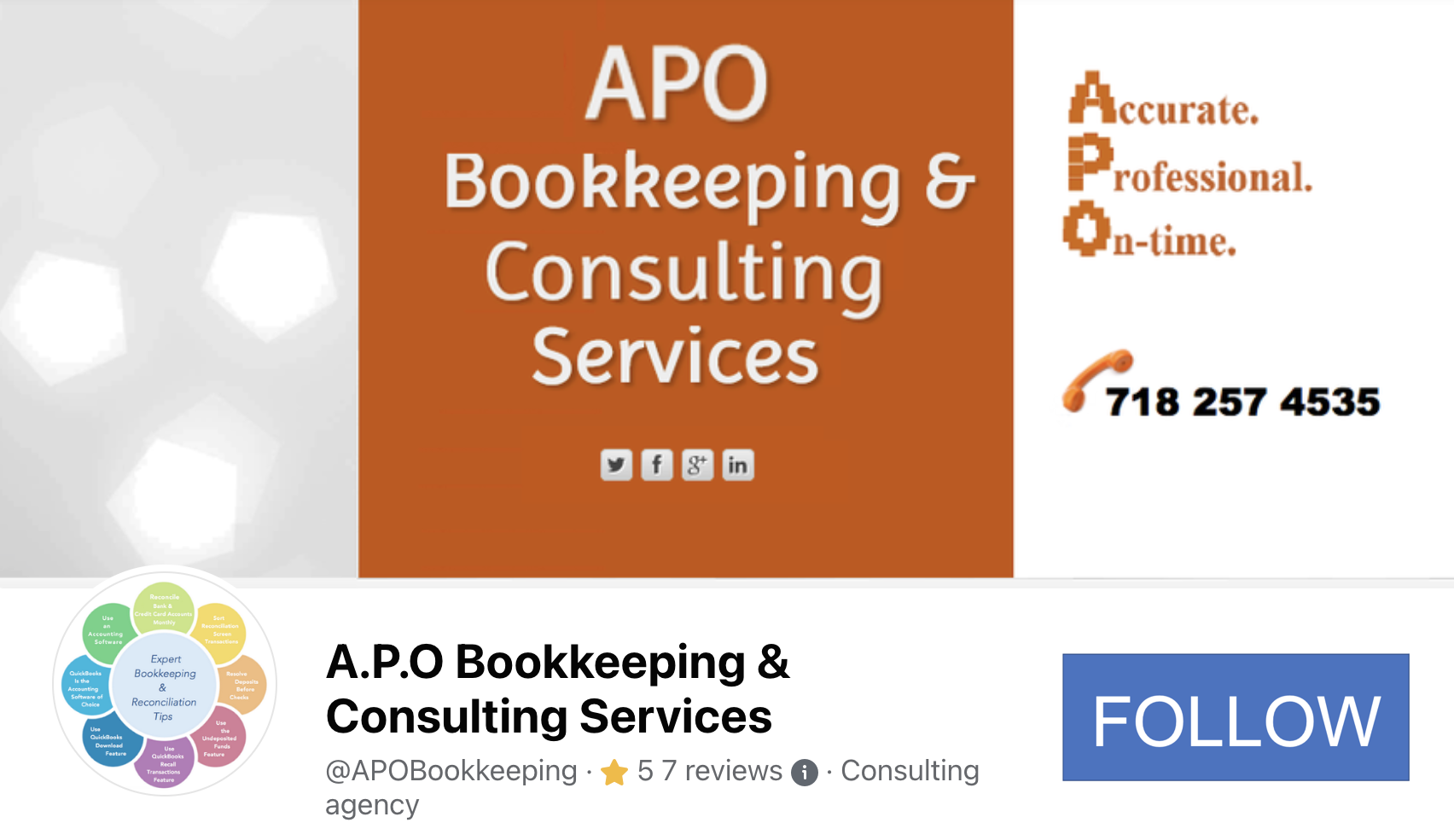by Eugénie M. Nugent | Dec 31, 2016 | Business Improvement, Business Tips
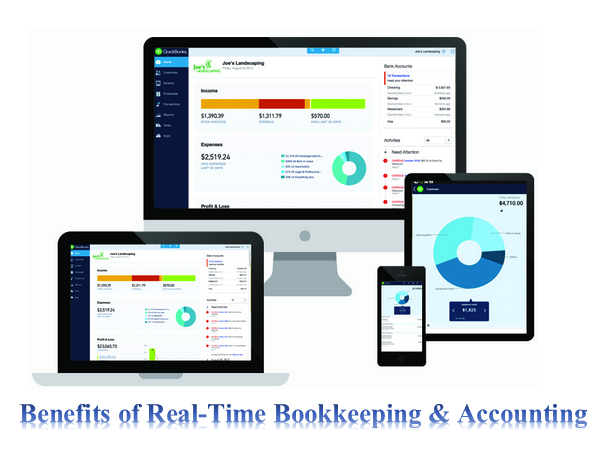
@APO Bookkeeping
Bookkeeping and Accounting can be boring! However, it is an essential part of your business as it gives you clear information about the status of your cash flow – how much money is truly available in your bank account for spending, who owes you money, who you owe money, how your business is performing overall and so it must be done. Many business owners who handle their own bookkeeping usually update their books on a monthly or quarterly basis; however, it is important to know where you are in your business at any given time – financially, and monthly or quarterly updating will not allow for such readily available information. Bookkeeping should be done in real time! Here are some of the benefits of real-time bookkeeping:
Real Time Bank Balances
In order to give you a true view of your available funds in your bank account, you must update your books on a daily basis. The balance your bank is showing as available at any given time, may not be as accurate as you think it is, unless of course you are using an accounting software such as QuickBooks Online and ensure daily updates. Without real-time Bookkeeping and Accounting your business cannot take into account outstanding checks that might affect your bank balance which the bank has not yet processed. Say for example your bank account balance shows a balance of $15,000 but you recently wrote a couple checks to your employees for your latest payroll, and your recurring rent payment through bill pay is not yet automatically initiated by your bank. Is your bank balance still $15,000? No, the true amount available in your bank is $15,000 minus any outstanding checks. Cloud accounting software such as QuickBooks Online or Xero will eliminate this shortfall as they both do an amazing job at tracking both the bank balance as well as your true available balance. However, this can only be effective if you use real-time bookkeeping and accounting procedure – daily updating.
Real-Time Cash Flow Analysis
It is very easy to overlook information that does not directly affect your business bank account such as business expenses afforded with personal funds. Employees reimbursement or business owner reimbursement may be omitted from your reports if they are not included in real time, which will undoubtedly give you inaccurate information and possibly a false sense of cash flow security when the cash isn’t really there.
“Without real-time bookkeeping and accounting you cannot gain a true perspective of your business stance, or your cash needs.” Eugénie M. Nugent
Real-Time Reporting
Bookkeeping and Accounting on a real-time basis offers you a greater level of information than if you updated your books sporadically. It allows you to have greater insight into your business performance by knowing you can generate a Financial Statement like a Profit & Loss in the middle of the month with real updated information. This is crucial to help you better understand if you are meeting your monthly monetary goals, as well as staying within your budget. Real-time bookkeeping update will help you predict how much cash is needed for ongoing expenses you might have by the end of a particular month, for example. Your accounts receivables and payables will be included in your reports – if you are operating on an accrual basis, making your reports more inclusive and true. Without real-time bookkeeping and accounting, you cannot gain a true perspective of your business stance or your cash needs.
by Eugénie M. Nugent | Nov 21, 2016 | Business Improvement, Business Tips
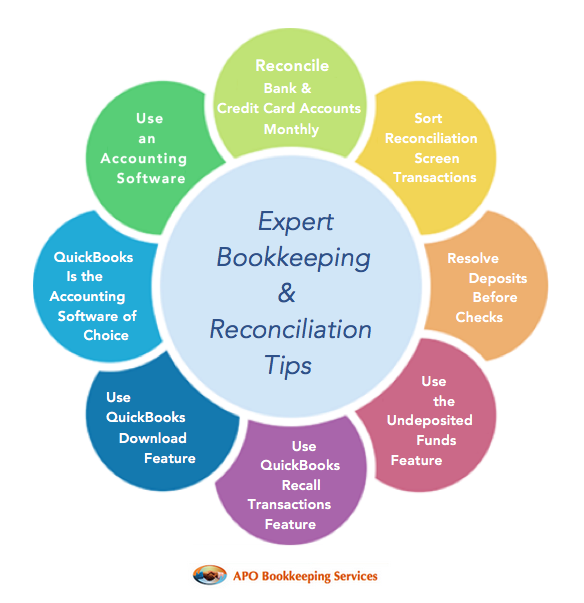
Photo courtesy of APO Bookkeeping
Reconciliation is a very important aspect of the bookkeeping and accounting process. It is also the only way to ensure your numbers are accurate. As such, reconciliation of the bank and credit card accounts should be done on a monthly basis, and a report of the reconciliation kept for your records. That said, reconciliation can be tedious especially if there are multiple accounts to reconcile and they are not done regularly. This where a software comes in handy! An accounting Software such as QuickBooks, will allow you to not only reconcile your accounts, but to easily download transactions from your bank and credit card institutions – into QuickBooks. Accounting software also allow you to have all your financial information grouped in one comprehensive system from which you can generate multiple useful financial reports. If you are using QuickBooks or thinking about using it, here are a few tips and tricks that will help you have a more pleasant, less onerous bookkeeping and reconciliation experience:
Take Advantage of QuickBooks Download Feature
QuickBooks download feature can go a long way in helping with your transactions input, as well as your reconciliations. After the initial banking and/or credit card online banking setup, you will only need to click one button called Update – periodically, in order to have your new transactions downloaded. You will need to review the transactions before adding them directly to the various QuickBooks register and accounts, but instead of manually entering all the information that pertains to each vendor or customer, you will only need to click one button for each transaction to be added to QuickBooks – in most cases. You may have to change the account that some transactions are associated with; however, that is minimal compared to entering every detail. This downloaded transactions process of easily adding information to QuickBooks, makes the reconciliation process easier. Manual entering can cause transactions to be missed or amounts incorrectly entered, but the download will enter them exactly as they should be, and so you will not spend time looking for a difference that could be due to $6,269 entered as $6,296 which is usually more difficult to locate. If you are using QuickBooks Online, you will have an added edge in matching the transactions because QuickBooks Online is Intuitive and will show you possible options for the transactions that would otherwise be elusive.
“The bookkeeping and the reconciliation process can be fairly simple if an effective accounting software is used, and proper procedures set up and followed.” Eugénie M. Nugent
Use the Undeposited Funds Feature
Reconciling the deposits on the statements with the deposits in QuickBooks can be an arduous task if Invoices were used and the payments received for those Invoices were not deposited to the bank in the amounts that they are in QuickBooks. In other words, if monies were deposited in the bank in one lump sum payment of multiple customers, and these payments were not grouped via undeposited funds and posted to QuickBooks bank register as such, it could be quite a task trying to figure out what deposits in QuickBooks make up a particular lump sum deposit on the bank statement. So, you want to make sure you are entering the transactions in QuickBooks with the reconciliation process in mind.
Resolve the Deposits Before the Checks and Other Payments
Like the deposits that are received from multiple customers and deposited to the bank in lump sum but not in QuickBooks, deposits from credit card merchants can also be problematic to reconcile. American Express, for example, groups weekend transactions together and deposit them as one lump sum deposit for the two days weekend sales, and so if you are manually recording some sales on a daily basis, that – topped with the payment portal payments can make it really difficult to match and reconcile. As you can see, reconciling these deposits could take some time, and you want to ensure sooner than later that all your deposits actually were deposited to your bank account. It rarely happens, but banks make mistakes too!
Use the Recall Transactions Feature Effectively
The recall transactions feature is a huge time-saver! After you have setup the preferences for QuickBooks to recall previous transactions information, QuickBooks will automatically recall the last transaction or account used for any vendor you have already paid. It can be a huge time-saving tool if used appropriately. For example, if you have an American Express Card, and you also accept payment through American Express Merchant Services, you can create three different variety of vendor names to make it easier to recall the transactions for each, rather than having to type in the different account information each time. Such as:
- Vendor #1 could be called Amex-4566 (last 4 digits on your Amex Credit Card) – which you would use to handle payments from your checking account to your American Express credit card
- Vendor #2 could be called Amex Finance Charge – which you would use to handle your finance charges assessed to your American Express Credit Card
- Vendor #3 could be Amex Merchant Fees – to handle your merchant processing fees charged by American Express
By doing this, QuickBooks will automatically recall your Amex credit card payments as coming out of your checking account, Amex Finance Charges as being a bank charge expense, and Amex Merchant Fees as being a merchant processing expense. If you set up your QuickBooks this way, you will only have to make minimal changes – if any, to the recalled transactions.
“Get yourself a good accounting software, set up protocols as far as the procedures, and ensure you and anyone designated to your bookkeeping and reconciliation tasks, use them.” Eugénie M. Nugent
Reconcile The Smaller Accounts First
If you are new to reconciliation, or reconciling your accounts using a software, I recommend starting with the smaller accounts with less transactions so you can: a) get some practice, b) feel accomplished in reconciling it more quickly, and c) get a boost to take on the bigger challenge. For example, you may start with all the credit cards and loan accounts before moving on to the savings, payroll, and then the general checking account(s). Also, the larger accounts are usually impacted by the smaller accounts, and so you want to first focus on the accounts that have an impact on the general checking account(s). Another important thing to do, is to ensure transactions such as third-party payroll to companies like ADP and Paychex, are entered into QuickBooks before adding your downloaded transactions into QuickBooks. This will allow the payroll transactions to be matched up to your downloaded transactions in your download review window.
Sort The Reconciliation Screen Transactions
If you have a large volume of transactions, knowing how to find and clear them quickly is super important. QuickBooks allows for the easy sorting of transactions by amount – smallest to largest and vice versa, check number order, etc. Sorting by amount can be a huge time saver, especially when trying to match the deposits. If you have credit card merchant deposits coming into the checking account you probably have a lot of unique numbers. Sorting by amount by clicking on that column can make your QuickBooks reconciliation process much more effective while helping you work more efficiently. Also, sorting the checks and payments side of the reconciliation by check number will allow you to easily check the numbers in number order. In addition, when going through the transactions on the bank statement, it could save a lot of time if you check off the transactions by the different statement sections. There are a few banks that do not separate them, but if yours do, it could save a lot of time.
Bookkeeping and the reconciliation process can be fairly simple if an effective accounting software is used, and proper procedures set up and followed. However, it can be quite the opposite if none of this done. Get yourself a good accounting software, set up protocols as far as the procedures, and ensure you and anyone designated to your bookkeeping and reconciliation tasks, use them.
What accounting software are you using? And, what steps do you take to help simplify your reconciliation process?
by Eugénie M. Nugent | Oct 29, 2015 | Business Improvement, Business Tips
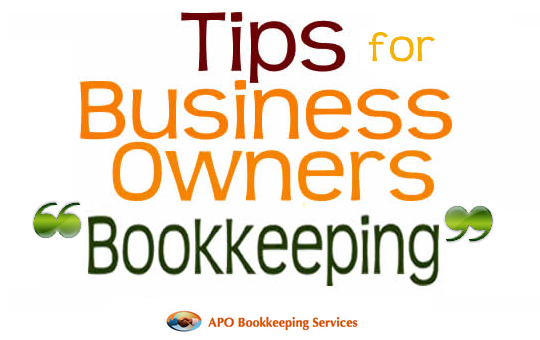
Photo courtesy of APO Bookkeeping
For any number of reasons, you may opt to do your bookkeeping on your own instead of hiring a bookkeeper in-house or outsourcing your bookkeeping. Like many things, there are advantages and disadvantages to doing your own bookkeeping, but with some basic accounting knowledge and a keen eye for detail you should be able to pull it off. Here are a few tips to help you as you do it on your own:
 Use the Right Accounting System
Use the Right Accounting System
Accounting is either cash-based, or accrual-based. With the cash method, you count the income when you receive it, and expenses when you pay them. Under the accrual method, you count income and expenses when they happen, and not when you actually receive or pay them – respectively. The other main difference between the two methods is the ability to budget accurately. Accrual method of accounting allows for better budgeting and planning because it looks at when liabilities are incurred and revenue earned and not when cash is paid. This method puts on the books liabilities that might otherwise be forgotten, like accrued interest. The cash method does not take accrued interest into account until it is required to be paid. This could put a strain on a small business that did not plan to pay out accrued interest balance, and is now faced with cutting expenses in other areas to have enough cash to pay the outstanding balance. The two methods have their advantages as well as disadvantages, and as far as filing taxes, the IRS only requirement is that you use the accrual-based system if your annual sales is more than $5 million or you store inventory.
 Record transactions as soon as they occur
Record transactions as soon as they occur
If you are using spreadsheets for your bookkeeping, or doing it manually on paper, you need to record your transactions as soon as they occur. If you are using an accounting software such as QuickBooks, you need to decide whether you will be recording transactions as they happen or adding them via the bank downloads later. Regardless of the method you use, keep your books updated at all times. Doing so will allow for little to no discrepancies, better workflow, and you will also have updated information on which to rely for decision making.
 Record all business transactions
Record all business transactions
In order to have accurate numbers from which to make good business decisions, and file correct tax returns, you need to ensure all numbers affecting the business is accounted for and recorded. For example, if you are a business owner who sometimes uses personal funds for business expenses – and vice versa, you need to include those numbers in your bottom line.
 Track Reimbursable Expenses
Track Reimbursable Expenses
As a Small Business owner, it is very likely to sometimes use your personal funds to for pay business expenses. These monies should be reimbursed to you as well as recorded in the company’s expenses, and so there should be an account created to keep track of these reimbursables. Also, if your employees are construction workers or engineers who are usually in the fields and may use their funds to make small purchases that are immediately needed in order to continue their work, you need to collect those receipts and add them to the reimbursable account from which you will later repay them. Doing this is also important for accurate job costing.
 Keep Accounts Categorization Simple
Keep Accounts Categorization Simple
Overcategorization leads to miscategorization and ultimately inaccurate reporting. As a small business, you should be able to categorize your accounts in three to four sections:
1) Income – under which you can create subaccounts of your various streams of income
2) Cost of Goods Sold or Cost of Sales – under which you can create sub accounts for the employees salaries who are directly involved in the creation of the products you sell or the services you offer, as well as the products purchased to be used in the creation of your complete product for sale.
3) Operating Expenses – under which you can create a subaccount for Administrative Expenses and further subaccounts under Administrative expenses to list those individual accounts.
4) Other Expenses – under which you can create subaccounts to list other expenses that do not fall under any of the above categories.
The balance sheet accounts are usually fairly standard with three main sections: 1) Assets, 2) Liabilities, and 3) Equity each with their own subaccounts. You will need to create additional accounts on as needed basis. For example, if you loan money to your company, you will need to create a liability account to record these amounts the company owes you. Likewise if you borrow money from your company, you will need to create an asset account to reflect this.
Here is an example of a Simple Profit & Loss Report or Income Statement:
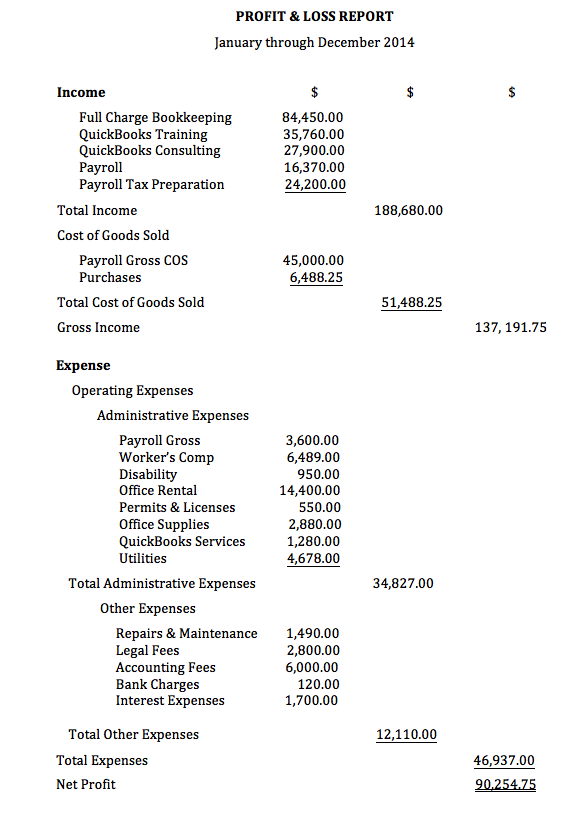
 Deduct Sales Tax from Total Sales
Deduct Sales Tax from Total Sales
If you are a retail business that collect sales tax on behalf of the government, you should deduct these sales taxes from your sales. If you are using a software such as QuickBooks for your bookkeeping, and you do not track inventory in QuickBooks, you can setup this account as an Income account and set it as a discount so that it will be listed at the top of your Profit and Loss report and lessen from the total sales. Also, avoid penalties and interests and pay over your sales taxes as soon as they are due.
 Keep Proper Records of Loans Received
Keep Proper Records of Loans Received
Many small business owners need financial backing at their startup, and may take out a loan or two. These loans must be recorded and tracked in separate accounts, paying special attention to separating the principal repayment and the interest payment. The interest is an expense to your company and should be recorded in the expense section of your income statement or profit and loss report, while the principal is made towards your loan balance which will be in your liability section of your balance sheet.
 Use Checks or Credit/Debit Cards Instead of Cash
Use Checks or Credit/Debit Cards Instead of Cash
Cash makes it harder to keep track of spending. Misplaced receipts, forgetting to document purchases all can be avoided if checks or debit/credit card payments are made. Not only will you have the amounts available to record, but you will also have details on uses of funds.
 Reconcile all Business Bank & Credit Card accounts every month
Reconcile all Business Bank & Credit Card accounts every month
This is one of the best business practices to employ! Reconciliation is a fundamental aspect of bookkeeping. Not only will you be able to catch any mishaps that occur; it will spread your workload and keep your books up-to-date-and accurate. Also, any mistakes on the bank’s or credit card company’s part that are not caught within six months, will not be able to be resolved. If you look on your statements, you will see that the banks include a reconciliation sheet and recommends that you reconcile your numbers with theirs. Reconciliation is the only way to ensure your numbers are accurate and your bookkeeping on par.
 Let Payroll Specialists Handle Your Payroll
Let Payroll Specialists Handle Your Payroll
Payroll and payroll taxes can be complicated/intricate and not only do you need to ensure your employees paychecks are precise, but you must make correct payroll deposits as well as file accurate taxes. Payroll specialists are trained especially for this, and so they know the ins and outs, and are fully equipped to get this done accurately.
 Keep a Proper Filing System in place
Keep a Proper Filing System in place
Not only is this good business practice, but you do not want to drive yourself crazy trying to find one document that is urgently needed – pronto. As a “do-it-yourselfer” it will greatly benefit you to keep a proper filing system where you will file all documents and paperwork in a manner that makes them easily retrievable.
 Keep an Eye on Your Cash Flow
Keep an Eye on Your Cash Flow
Cash is King for any business, and the lack of it is the reason so many small businesses fail. Know how much it takes to keep your business running on a monthly basis! Devise an accurate system of expenses and monthly obligations, and weigh them against your reliable monthly inflow of cash. Include an extra 20% of total expenses to your expenses for a bit of “cushion”. A budget and forecast report is a huge plus to create, maintain, and use as a financial guide.
 Give Your Customers Options to Pay You
Give Your Customers Options to Pay You
Providing your customers with a variety of payment options will not only make your customers happy as far as convenience, but it will allow you to get paid more quickly. In today’s fast paced world, convenience goes a long way! Some customers may procrastinate writing that check AND mailing it, or setting up that online bill pay. Allowing them the option to pay you via your submitted invoices will be a huge plus in helping your cash flow.
 Invoice Customers on Time
Invoice Customers on Time
The sooner you bill your customers the sooner you will get paid, and that will also help keep your cash flow up and your budget on track.
 Pay Bills on Time
Pay Bills on Time
Pay attention to those vendors who are sacking a late payment fee to late payers. Take advantage of those terms of payments you get, but make every effort to meet them. The delay will help with your cash flow, but may accrue interest if not paid on time.
 Have your vendors submit a completed and signed W9 form
Have your vendors submit a completed and signed W9 form
For vendors to whom you have paid a minimum of $600 and above during the year who are not a corporation, you will need to report their payments to the IRS on from 1099-Misc at the end of the year. You will need specific information from them to include on this form such as their mailing address and tax identification number. It is best to keep W9 forms on hand, so that you can have your vendors complete them at the time you realize that the monies you are paying them are at this threshold. You should check your vendor balances to see if the monies you have paid them are amounting to $600 and above, as you may often write a check for under six hundred but may make more payments to them amounting to $600 and above throughout the entire year. Waiting for year-end to collect this information may be a daunting task, which many times – from my experience, has proven futile. You cannot file form 1099 without the vendors tax identification numbers, and of course you will need to mail their copies to them. If you pay your vendors through a Payment Portal such as Paypal or with your credit card, you will not be required to file or include those amounts on your 1099 as these companies are already reporting them on their 1099k.
 Backup Your Computerized Information
Backup Your Computerized Information
Computerized systems as well as software do fail at times, and it would be devastating if all the work you have put in to your system were to become corrupt beyond repair, or inaccessible. Portable Hard Drives like this Toshiba Canvio Connect II 1TB Portable Hard Drive or this Seagate Backup Plus Slim 2TB Portable External Hard Drive with Mobile Device Backup USB 3.0
or this Seagate Backup Plus Slim 2TB Portable External Hard Drive with Mobile Device Backup USB 3.0  will store a copy of your information for easy retrieval, and save you the headache of ever losing your information that you have worked so hard at compiling.
will store a copy of your information for easy retrieval, and save you the headache of ever losing your information that you have worked so hard at compiling.
 Leave an Audit Trail
Leave an Audit Trail
If you have a system that allows you to quickly and easily retrace your company’s financial activities, your record keeping is effective. This includes keeping your invoices and checks in numeric order, not skipping check or invoice numbers, and keeping bank and credit card accounts separate. You should be able to retrace a year or years and have a clear trail of your company’s financial activities.
The best way to work as a “do it yourselfer” and not be overwhelmed, is to always keep every area of the business up-to-date. Designate a time to get the tasks that can be done later such as recording reimbursables and paying bills, and do the ones that cannot wait – such as Invoicing and attending to your customers first. Create a monthly chart with a daily workflow that you will be able to model everyday, and stick with it.
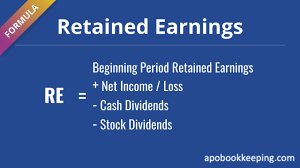

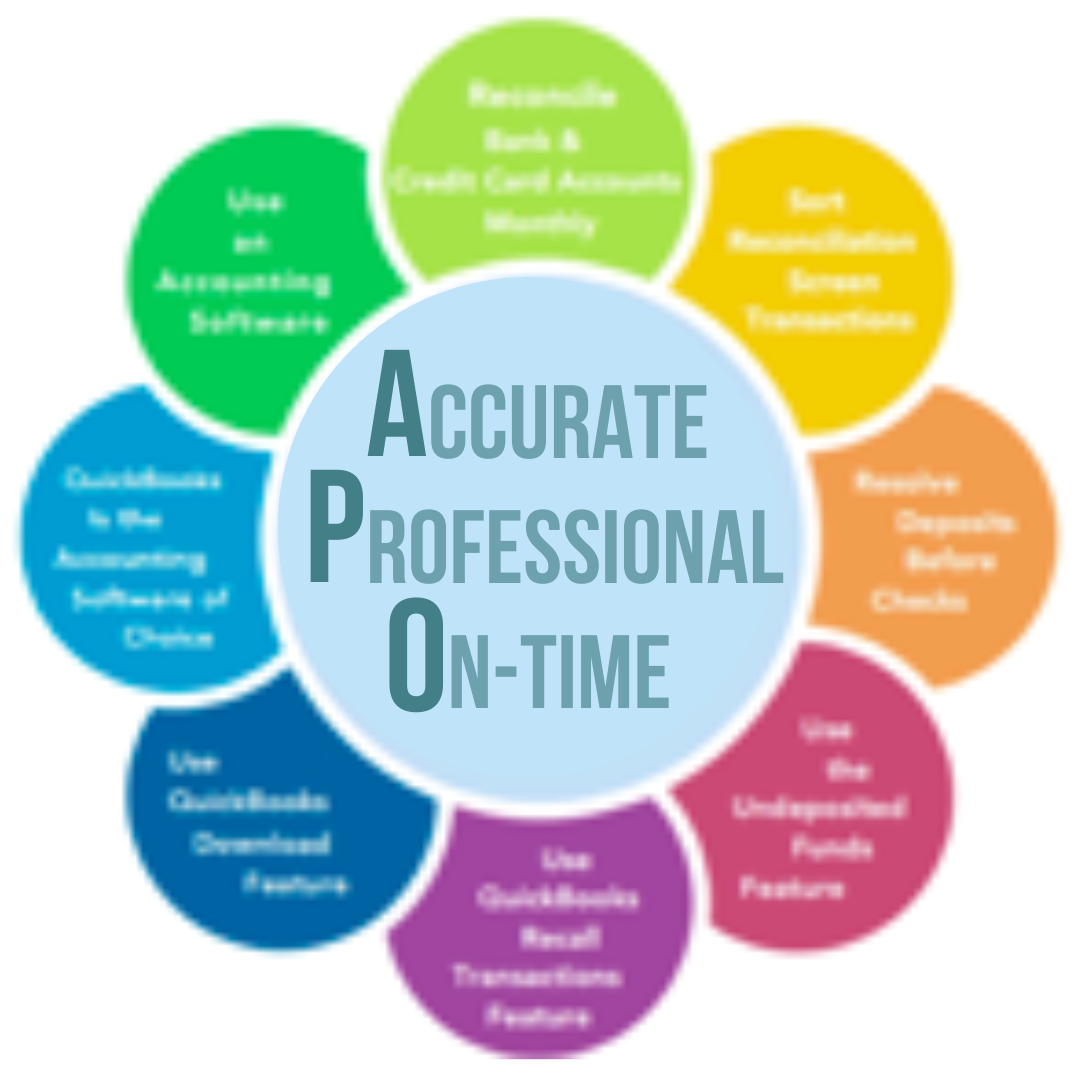
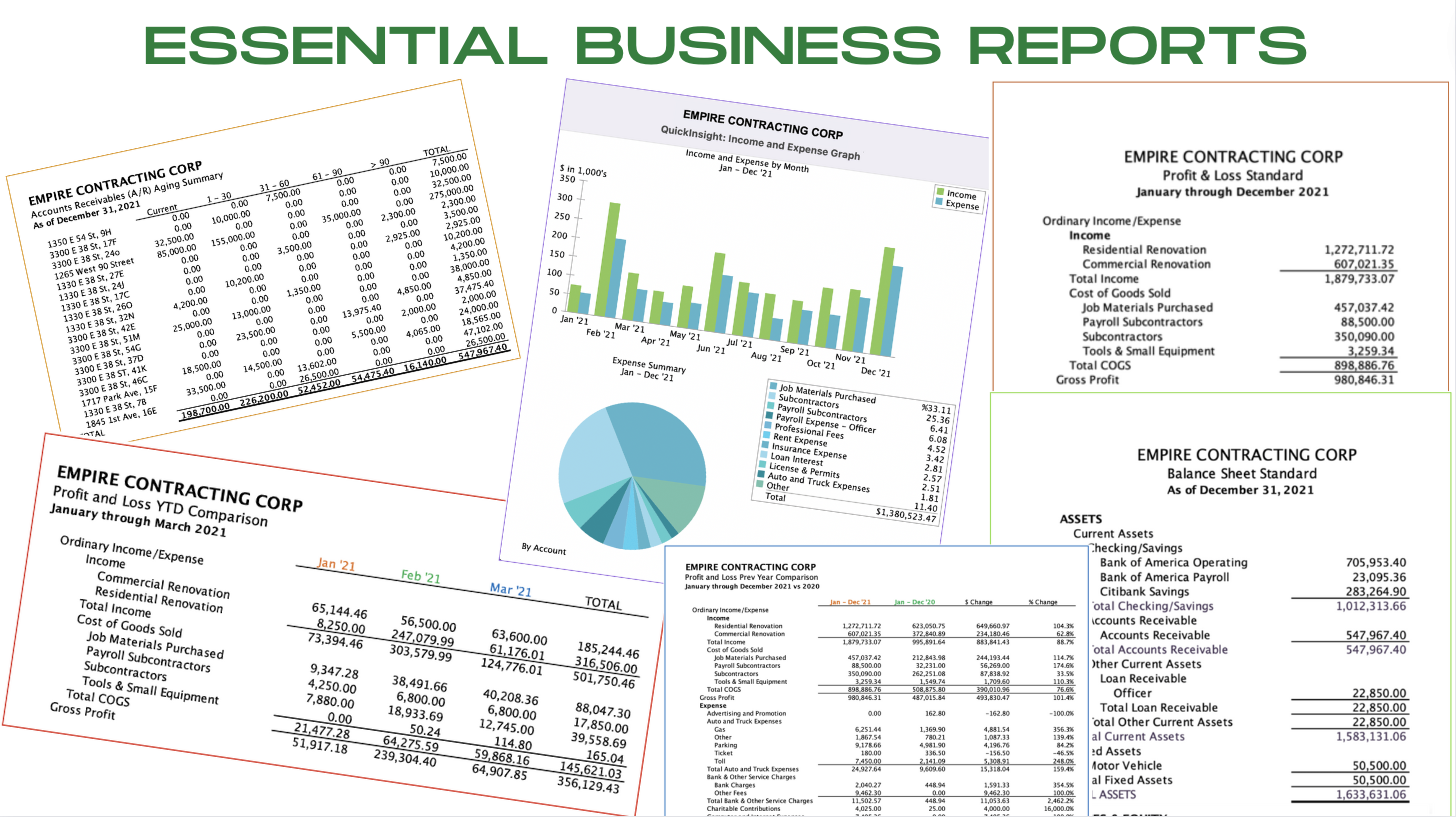 Doing your own small business bookkeeping can be a very simple process; however, there are things that must be in place to ensure you are doing it correctly so you can retrieve accurate reporting from which to make good business decisions as well as file accurate taxes.And no, there is no way to avoid bookkeeping if you are running a legitimate business. You can
Doing your own small business bookkeeping can be a very simple process; however, there are things that must be in place to ensure you are doing it correctly so you can retrieve accurate reporting from which to make good business decisions as well as file accurate taxes.And no, there is no way to avoid bookkeeping if you are running a legitimate business. You can 


 Use the Right Accounting System
Use the Right Accounting System


